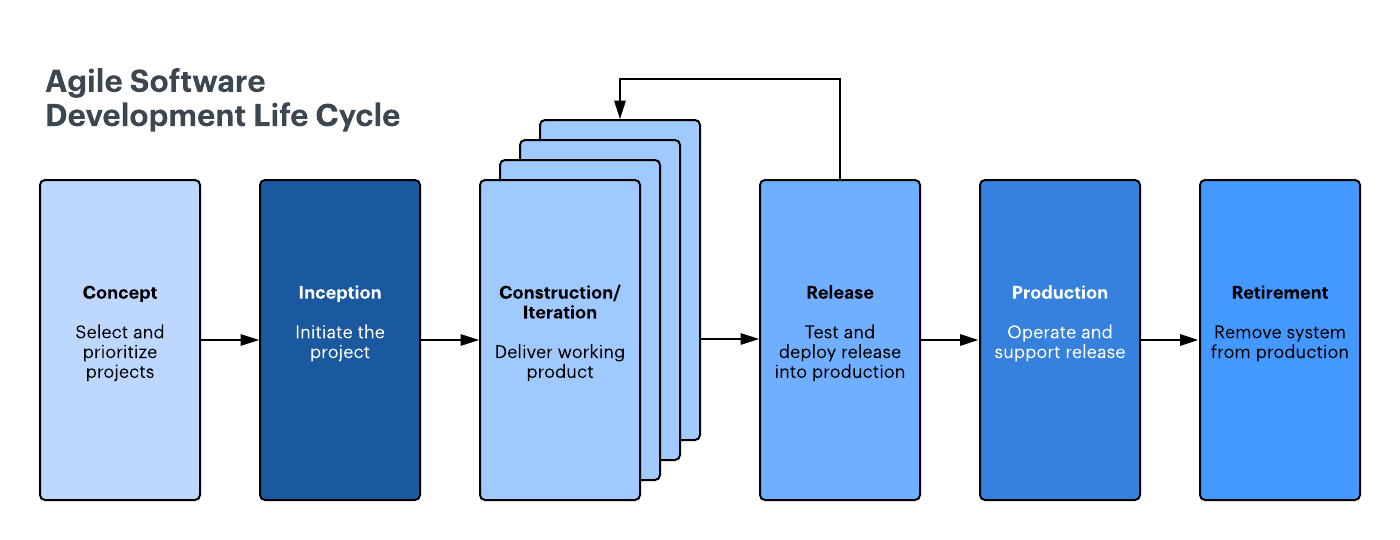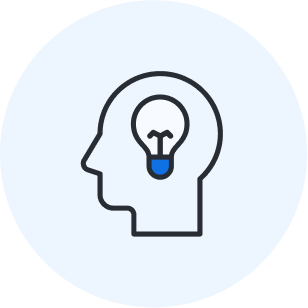Agile development. Agile operations. DevOps. The world of software development likes its buzzwords. But it’s easy to get lost in the jargon.
And when definitions start to blur and meanings become squishy, these words lose their value. That’s why we’ve created this crash course in Agile operations. Discover the difference between Agile development and Agile operations, and learn what Agile operations can do for your team.
What is Agile operations?
The term "Agile operations" is thrown around a lot among development teams and organizations, often with differing definitions. Some use the term generally to refer to the application of Agile principles to run operations. Others use the term interchangeably with DevOps.
In this context, we will use Agile operations as an umbrella term to refer broadly to the application of agile principles and methods for both development and operations in an organization.
To better understand this term, let's break down the Agile framework.
What is Agile?
The Agile Alliance defines "Agile" as the ability to create and respond to change in order to succeed in an uncertain and turbulent environment. These are the characteristics that the founders of the Agile methodology sought to embed in their new approach to software development.
Agile’s highest priority is “to satisfy the customer through early and continuous delivery of valuable software.” To accomplish this goal, Agile operations rely on the founding principles outlined in the Agile Manifesto:
- Individuals and interactions over processes and tools
- Working software over comprehensive documentation
- Customer collaboration over contract negotiation
- Responding to change over following a plan
By emphasizing communication, flexibility, and functionality over time-consuming planning, process, and documentation, Agile teams are able to deliver functional, competitive results more rapidly.
What is DevOps?
DevOps is a method born out of the Agile movement that focuses on bridging the gap between the development and operations teams.
Traditionally, the two units commonly butt heads and operate on different values. Where Agile development teams focus on faster, more frequent releases, operations teams are responsible for maintaining a stable service. This dichotomy can lead to delays and bottlenecks as both teams work to meet their objectives (i.e., fast, functional delivery vs. safe, operational readiness).
The DevOps process applies an Agile mindset to both the development and operations departments with a particular focus on communication, collaboration, integration, and automation.
The Agile process and iteration
Agile operations and development will look different depending on the methodology and organization. However, most will follow the same basic lifecycle and iteration workflow.
Agile software development lifecycle
Agile development has six basic stages in its lifecycle:
- Concept: Stakeholders envision and prioritize new projects.
- Inception: The project takes shape as team members are assigned, budgets and timelines are put in place, and requirements are outlined.
- Iteration/construction: The team begins active development to meet the requirements with regular customer feedback.
- Release: The feature undergoes QA and testing, users are trained, and the iteration is released into production.
- Production: The feature is deployed and receives ongoing operational support and maintenance.
- Retirement: The feature is retired. The customer is notified and the team implements a migration process.
From concept to iteration, Agile methods are primarily performed by the development team. However, the operations team gets involved during the release and production stages to ensure quality, security, and stability upon implementation. If your teams aren’t communicating well, these are the phases where competing values and objectives can send your project off track.
To enjoy a truly Agile operation from concept to retirement, communication and collaboration is necessary. Whether you apply a DevOps method to bridge that gap or simply cultivate an Agile culture and process between the two departments, both the development team and operations team need to be on the same page.

What is an iteration in Agile?
During Agile product development, there will be multiple iteration stages (or sprints). Each Agile iteration builds on the previous iteration as developers work out issues and adapt to ongoing customer feedback.
Iteration planning in Agile will typically follow this process:
- Requirements: As part of Agile release planning, the requirements for the iteration are mapped out based on customer feedback and the backlog priorities.
- Development: Developers design and build the feature based on the defined requirements.
- Testing: Once the feature is “complete,” testers conduct QA and validation checks to ensure the iteration functions properly.
- Delivery: The working iteration is shipped to production.
- Feedback: Developers communicate with stakeholders (client/end-users) to collect feedback and identify requirements for the next iteration.
Agile benefits to improve operations
There are many benefits to taking an Agile approach to development and operations.
Greater customer satisfaction
Agile operations rely on constant communication and feedback with stakeholders. Because development is iterative and incremental, clients are able to identify requirements changes as the need arises and effectively build the product to their exact specifications. With such high collaboration and customization, customers tend to have greater satisfaction with the end product.
Increased project control
In traditional development methodologies, developers were constrained by a strict schedule with little room to adapt to evolving needs. Agile’s iterative nature gives developers and clients alike greater control over the project and its outcomes. Whether a customer wants to add new requirements or there are changes in the market landscape, developers have the power to pivot and address those new factors.
Higher product quality
Agile operations integrates Agile testing into your production process. Daily testing and validation ensures that issues are identified and addressed promptly, leading to a higher quality iteration.
Faster ROI
Instead of waiting months for a full product release under traditional Waterfall development, Agile delivers features incrementally. This methodology allows customers to realize the benefits (i.e. return on investment) sooner while the product is still in active development.

Learn more about the benefits of Agile
Check out our All-access Agile series to discover more information and resources on the Agile mindset.
Learn moreHow to switch over to Agile operations
If you’ve been working with the Waterfall method, you’re likely used to finite development, delivery, and operations phases. With Agile development and operations, there is no finite delivery of a completed product. Rather, the product is delivered—and redelivered—as testing occurs and adjustments are made to the system.
As you make the switch to Agile operations, you’ll want to consider your team’s workflow and data integrations and be prepared to overhaul your team’s approach to how your work is managed, completed, and delivered. To ease the transition, take the following steps.
1. Train your staff
Before springing Agile principles on your team, it’s important to help your team understand what will be expected of them and what their role will be within this new framework. As you introduce new processes or adopt sprint planning, consider holding a few training sessions to ensure that your organization’s goals align with team capabilities and expectations. You can employ any books or blogs on the subject or hire a professional to offer guidance as you lay down the crucial groundwork you need to switch over to Agile.
2. Emphasize flexibility and adaptability
Focusing on the old approaches to work will only lead to friction as you try to encourage Agile thinking. While it might be a challenge for some teams to make the switch, team leaders should encourage their teams to stay focused on the benefits of Agile techniques, tweaking their processes or abandoning old ways altogether.
One way to encourage this is to emphasize people over processes. Even engineers, IT personnel, and developers, who are typically steeped in process, should be encouraged to think outside of their rigid procedures in order for Agile methodology to thrive.
3. Foster collaboration and communication
Communication is one of the fundamental tenets of the Agile process, as it facilitates critical development and testing activities. With healthy communication and collaboration within and across teams, team members can more quickly identify problems as they arise and implement effective solutions. Establish a clear line of communication between teams to ensure that pain points, updates, and solutions can be readily shared when needed.
Implementing Agile techniques ultimately requires focusing on the end product over process, which can be difficult for some teams to grasp. While making the switch to Agile operations can be daunting, inspiring confidence and enthusiasm in your team is half the battle. By creating an environment where teams are empowered to make decisions, plan effectively, and collaborate freely with other stakeholders, your switch to Agile operations will be a smoother, more productive process.
Potential obstacles and how to work through them
Making the switch from a strict milestone-driven process to one that thrives on flexibility is likely to cause a hiccup or two. However, any potential barriers are easily worked through. Keep reading to see which barriers might be an issue for your team and how to solve them.
1. Excess formal documentation
While a traditional Waterfall approach requires a list of requirements before a project begins, this kind of approach isn’t entirely suited to an Agile approach. Clients may also ask for a heavy amount of user stories or a combination of user stories and requirements documentation, which can restrict Agile implementation down the road.
How to work around it: Open communication and an open mind are always the best routes to trying to sell an Agile approach to a client. Provide your client with a product roadmap or process overview to manage expectations, confirm key deadlines, and communicate project goals. This basic documentation also allows for a higher degree of flexibility as you and your team move forward, which is crucial for a successful Agile approach.
2. Operations stability
Operations teams are often under pressure to make their processes leaner and more effective while also aiming for a secure, stable system. This can often lead to conflict. Depending on your operations team’s release, approval, or documentation requirements, you may find your Agile processes delayed.
How to work around it: A DevOps team in which Agile development and operations teams work together can prevent a number of issues, including risky code changes and stressed-out operations engineers. A heavy focus on building better, more automated processes may also help to improve your cycle time while reducing your risk factor significantly. Both of these solutions work to complement Agile operations well and can actually turn your ops team into a major Agile asset.
3. Management
You might see a shift or a dissolution of your management’s functions as your switch to Agile operations. This may lead to some resistance or uncertainty within your team as line management becomes less important or service managers become less involved.
How to work around it: Your team might not have as much use for management roles, but that doesn’t mean these roles need to dissolve altogether. Instead, empower those in management roles to take on work outside of managerial responsibilities. Encourage open communication amongst your team members to ensure that you’re aware of any uncertainty or discomfort.
4. Project funding
In traditional project management, funding is based on the business case submitted at the beginning of the project, which accounts for project scope, value, risk, etc. The restrictions caused by the business case can lead to constraints later in the process, without room to adapt or innovate. If funding is allocated to creating X, Y, and Z, but they turn out to be inefficient additions to the product, your team needs to be able to explore alternatives as they see fit.
How to work around it: Agile funding should leave room for adaptability. So rather than funding projects, experts suggest funding products and the individual workstreams needed to create them. Each workstream is prioritized based on the value that work is able to contribute to the end product. Funds can be adjusted as the project goes on based on evaluations by the product owner and project managers.
Armed with this information, your organization can establish Agile operations and innovate and produce quality products faster.

When your organization is ready to make the switch to Agile operations, learn how to begin release planning.
Read moreAbout Lucid
Lucid Software is a pioneer and leader in visual collaboration dedicated to helping teams build the future. With its products—Lucidchart, Lucidspark, and Lucidscale—teams are supported from ideation to execution and are empowered to align around a shared vision, clarify complexity, and collaborate visually, no matter where they are. Lucid is proud to serve top businesses around the world, including customers such as Google, GE, and NBC Universal, and 99% of the Fortune 500. Lucid partners with industry leaders, including Google, Atlassian, and Microsoft. Since its founding, Lucid has received numerous awards for its products, business, and workplace culture. For more information, visit lucid.co.

